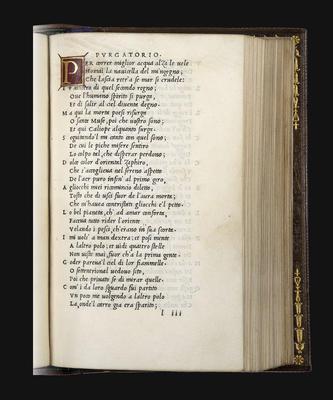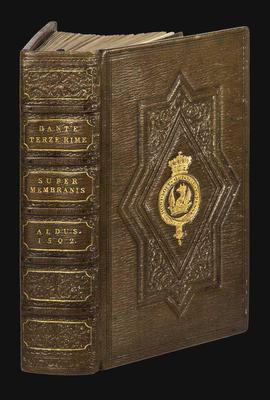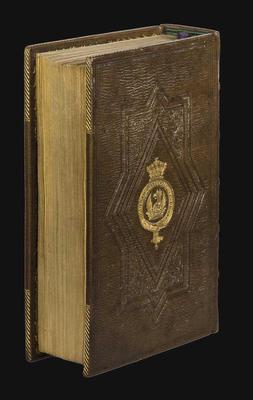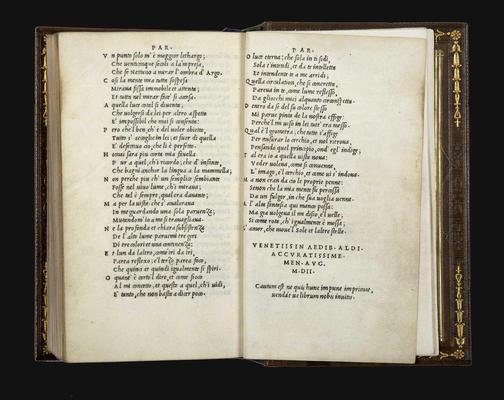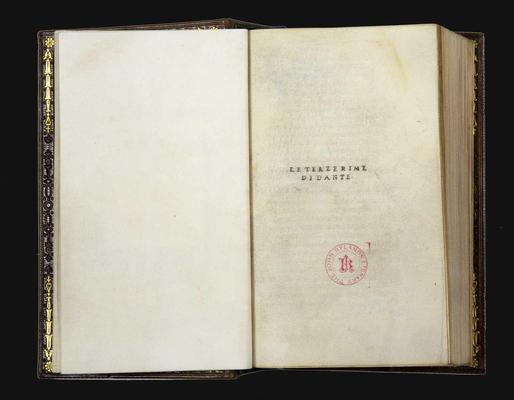Dante Alighieri
Le terze rime di Dante .
Venice, Aldus Manutius, August 1502.8° (157x91 mm). Printed on vellum. Collation: a-z8, A-G8, H4. [242] of [244] leaves, the first original leaf lacking and supplied in facsimile with the inked one-line title on the recto and the two-line one on the verso; the blank leaf l2 supplied in later vellum. Italic and roman type. At the beginning of each cantica illuminated initials in gold on black, maroon or blue ground. On the verso of the last leaf the Aldine device. Fine armorial binding, straight-grain olive morocco over thin wooden boards, unsigned but made for George John, 2nd Earl Spencer by Charles Hering after 1799, when Spencer was made a Knight of the Garter. Boards stamped in blind with sixteen-side plaque enclosing the Spencer crest in gilt (a ducal coronet, a gryphon's head and wings, gorged with a bar gemelle, and coronet of an Earl of the Order of the Garter). Spine with five raised bands, gilt and blind-tooled; title, imprint and ‘super membranis' in gilt lettering. Pastedowns and flyleaves lined with olive watered silk, inside dentelles and corner fleurons. Blue silk bookmark, gilt edges. Original blue roan slipcase. A very fine copy.
Provenance: erased contemporary ownership inscription on fol. H4v; small monogram in red ink combining the letters ‘A' and ‘s' on fol. a2r; George John, 2nd Earl Spencer (1758-1834; armorial binding); John Rylands (1801-1888); John Rylands Library, later University Library, Manchester (label dated 1894 on the verso of the front flyleaf, and small red stamp on fol. a1r; copy sold in 1988); Bibliotheca Philosophica Hermetica, Amsterdam (label on the front vellum flyleaf); Livio Ambrogio collection.
One of only six recorded copies printed on vellum of the first Aldine edition of Dante'sCommedia, in the issue containing the first appearance of the Aldine device – a dolphin wrapped around an anchor – used thereafter in all Aldine publications. The edition – in contrast to tradition entitled by Manutius simply Le terze rime – signals a linguistic restoration of the work and an important advance in the recovery of the original text. It was carefully prepared by the Venetian patrician and humanist Pietro Bembo (1470-1547), who used as his primary source an authoritative mid-fourteenth-century manuscript taken from the library of his father Bernardo, which Boccaccio had sent as a gift to Petrarch between 1351 and 1353 (Biblioteca Vaticana,msVat. Lat. 3199). The second identified source is the Landino edition of 1481, which had become the standard text of the Commedia by the end of the fifteenth century. According to Bembo's own notes in the copy-text – now in the Vatican Library – the editorial work began on 6 July 1501 and was finished on 26 July 1502. Aldus published the text in August 1502; it is assumed that Bembo sent the quires in sequence to the printer as he finished work on them.
The Aldine Dante is quite different to all previous editions of the poem. For the first time the Commedia is set in italic type and printed in the easily portable octavo format, unencumbered by the extensive commentary which, from the Vindeliniana onwards, had always accompanied Dante's cantiche in the earlier and larger format editions. The colophon is followed by Aldus's warning against counterfeited editions, “Cautum est ne quis hunc impune imprimat, uendat ue librum nobis inuitis”.
From the library of George John, 2nd Earl Spencer, who amassed one of the most prominent Aldine collections of all time. His librarian Thomas Frognall Dibdin mentions this ‘resplendent' vellum copy in various of his writings, including his well-knownBibliographical Decameron (1817).


